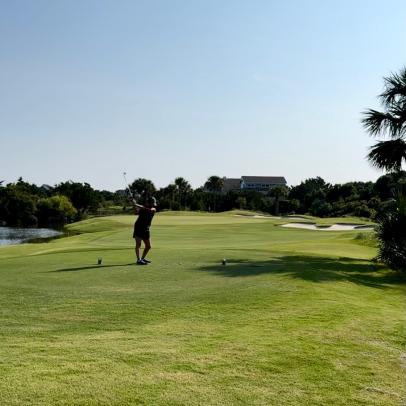A survival guide to your nightmare hole – Australian Golf Digest

- by Admin
- September 23, 2024

This article first appeared in Low Net, a Golf Digest+ exclusive newsletter written for the average golfer, by an average golfer. To get Low Net directly in your inbox, sign up for Golf Digest+ here. Have a topic you want me to explore? Send me an email and I’ll do my best to dive in.
You know your nightmare hole not just by what you see. You know it because you probably groan when you arrive at the tee. Or your pulse quickens.
Your nightmare hole doesn’t even have to be a bad hole. The 16th at my club is a stout par 4, the fairway cascading downhill toward a sloping green, water off in the distance. It’s a beauty, and totally fair. It also gives me fits. Last week before a round, I vowed I wouldn’t make double there, and I kept my word. I made 7 instead.
One of the reasons my nightmare hole is a nightmare is because of where it falls in the round.
It is near the end, but there’s still time to tilt the experience in a certain direction. This summer most of my most promising scores have been derailed there. I push a drive way right, or blade a bunker shot. None of these things are as pronounced a problem anywhere else, which begs the question if the problem is in my head. Of course it is. Or at least most of it.
More From Golf Golf Digest Logo What really happens when you ‘find something’  Golf Digest Logo The four biggest reasons you’re making double
Golf Digest Logo The four biggest reasons you’re making double  Golf Digest Logo My wife is brand new to golf—here’s what she’s taught me
Golf Digest Logo My wife is brand new to golf—here’s what she’s taught me
To understand why we tend to get tripped up the same way every time on certain holes, I asked Will Robins, a Golf Digest Best Young Teacher, for some universal advice on why certain holes have our number, and how to reverse the trend.
“Scratch the record”
Robins’ first piece of advice was also the most extreme. For whatever reason, certain holes pull us into a rut we can’t easily escape. It’s a pattern that requires a disruption—what he calls “scratching the record”—that helps us reframe the experience. So you try to do something completely different—go out to the hole one night and purposely hit a series of drives way out of bounds, he says, or purposely blade shots out of the bunker. The weirder the better, he says, because you’re trying to forge a new memory.
“What actually happens is during that moment, you trigger such a response that you can’t play the record again,” Robins said. “You can’t go back and go, ‘Poor me. This happened to me,’ because your brain is completely freaked out, right?”
If this sounds familiar, it’s because Robins is prescribing a version of the method captured in the movie “Tin Cup,” when Kevin Costner’s Roy McAvoy is saddled with the shanks, and Cheech Marin as his caddie tells him to put all his change in his left pocket, tie his shoes in a double knot and turn his hat around. None of it made any sense, but it distracted McAvoy enough to hit the ball square.
“You’ve changed your physiology,” Robins said of such moments. “You’ve changed your pattern.”
Change the par
Granted, not all of us have the luxury of making a special visit to a hole for the explicit purpose of hitting goofy shots. But there are other ways to reframe your thought pattern. One is to change your expectations of what constitutes “par.” On my nightmare hole, I’m so consumed with hitting a good drive that will give me a decent look at the green, yet my insistence on hitting driver is often what sends me into a tailspin. If I thought of it as a par 5, I might not feel the same strain.
“What would you do if you decided you need to get the ball on the green in three instead of two,” Robins said. “You’d just want to keep the ball in play, right?”
Much as laying up off the tee contrasts with most modern course-management advice, Robins says this isn’t about optimal scoring and more about approaching the hole through a new perspective. This helps in another way …
What’s the worst that can happen?
All my groaning and fidgeting and swearing to do better on my nightmare hole underscores the fact that I’m trying too hard. Tension is a killer in golf, and while sometimes unavoidable, the purpose of changing thought patterns and even par is to stop getting in your own way. Another way to do that is to pick an outcome you can live with and go from there. As Robins said, it’s a way of tapping into our “second-ball golfer,” the one who usually far outperforms the one from moments earlier.
“You lower tension, and if you lower tension, you increase ability,” he said. “I always tell my players, ‘if I gave you a tennis racket right now and a golf ball and I told you to hit it left, you’d just hit it left.’’ That’s how easy golf is. But you don’t play it that way because you’re thinking about your technique, and your shoulder, and your elbow, and your club face, and your back. Don’t worry about that. However you want to do it, just miss it left.”
This article was originally published on golfdigest.com
The Latest News
-
November 15, 2024Australian bounce India’s arch-enemy amid KL Rahul dilemma
-
November 15, 2024Nick Kyrgios set to make long-awaited return to tennis as comeback date revealed
-
November 15, 2024List wins elusive DP World Tour card, Barron loses his
-
November 15, 2024India great warns ‘the king is back in his territory’ as struggling Virat Kohli returns for fifth tour
-
November 15, 2024‘Adaptable’ Murphy spins out WA to put Vics in control | cricket.com.au





